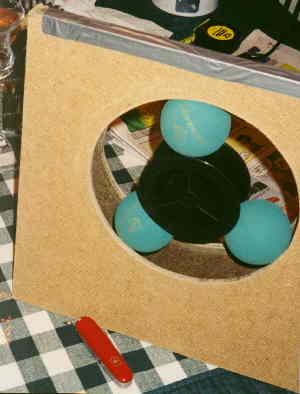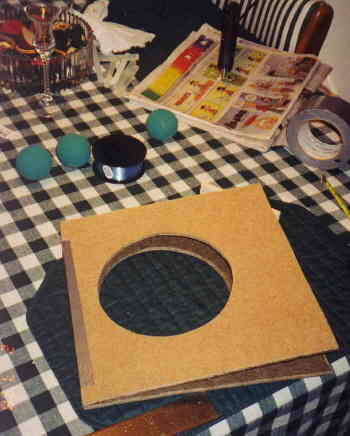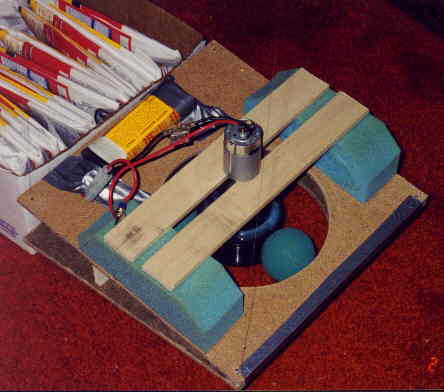
 Not being one to sit quietly by and let everyone else have all the fun :),
I picked up some essential supplies on the way home from work Friday night.
Saturday morning saw the beginning of frenetic activity.
Not being one to sit quietly by and let everyone else have all the fun :),
I picked up some essential supplies on the way home from work Friday night.
Saturday morning saw the beginning of frenetic activity.
In the first picture you can see the raquetballs, a reel of fishing line, and the basic "flying wedge" GIT configuration made of two 1-foot square pieces of hardboard.
In the background are construction essentials - duct tape and glue gun. I used a compass made of a piece of wood to scribe the 7" race circles and cut them out with an electric sabre saw. It would probably be more accurate to cut directly with a router on some type of compass jig.
I used duct tape to hold the race halves together initially, and then ran a bead of hot melt glue along the inside of the seam. I held the wide end of the race apart to the approximate desired width while the glue set.
Two small pieces of wood glued towards the wide end between the race halves complete the wedge construction.
The fishline reel is used as a drive wheel. With two edges it nicely rolls against the raquetballs. I unwound the fishline from the reel and saved it for use in the pendulum test to come.

The motor supports are made of some dense plastic or rubber packing foam material which is easy to cut and glue in place.
The motor is a 7.2 volt electric motor borrowed from a motorized radio-control glider. The battery pack is 7.2v comprised of a half dozen NICAD cells.
At first I had the motor driving the fishline drive wheel through a loose three-finger coupling; however, with that arrangement the orbitals would derail very quickly and fly out.
I finally glued the drive wheel to the motor shaft; this worked considerably better, although not perfectly. Now we were almost ready for the watershed event, THE PENDULUM TEST!
Do you remember the toy football games we used to play with as kids? The football players were mounted on two plastic ridges and placed on a vibrating table. The vibration of the table caused the players to take off and move at amazing speeds. We want to be sure that our GITs are not simply showing an effect like that.
Take your GIT to be tested and suspend it on fishline from some height. Allow it to settle in a vertical, or "plumb" position. Move somthing up against the "back" of the GIT to act as a reference "benchmark".
Now, turn the GIT on.

If the GIT is truly producing an inertial, unidirectional thrust, it will MOVE AWAY and REMAIN AWAY from the benchmark.
Sorry, but it does not count if it just "vibrates", "oscillates", "gyrates", or "bounces", even if the "average" position seems to be forward of its plumb position, if the GIT cannot maintain its distance from the benchmark.
It IS ok if the GIT is not entirely stable; as long as it has moved away and does not return into contact with the benchmark object during the time it is running.
Air is insubstantial enough of a medium that a good, sustained deflection of the pendulum without any "wind" blowing will be a very convincing proof of the validity of the GIT concept.
First, heavier balls... - I need to fill the raquetballs with some massive material, or replace them with handballs or something heavier.
Second, I need better alignment of the drive wheel and races, perhaps a bevel cut on the circular tracks to help hold the balls in (they had a bad habit of running up on the side of the race after about 10 seconds of operation and jamming the rotor).
Third, I need a mechanism for keeping the balls separated.
I still expect to get a GIT to pass the pendulum test, but it will take less haste and more careful design/construction on my part. I hope your attempts will benefit from my mistakes.
By the way, I welcome your comments and suggestions for improvements! :)
Tune in again next time for more exciting GIT adventures!